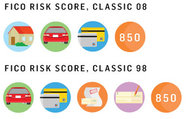As a consumer, you hear a lot about the importance of maintaining a good credit score. Most often, that means your FICO score — the score developed by the company of the same name to help lenders evaluate the creditworthiness of a potential borrower. But it probably makes more sense to talk about your credit scores, plural.
That’s because other outfits produce credit scores, too — and FICO itself has many different varieties of scores, depending on the type of loan you’re seeking. In fact, John Ulzheimer, a credit expert, has worked with Creditsesame.com to create a snazzy infographic (which you can click on above, and then zoom in on) showing a total of 49 different versions of your credit score under the FICO umbrella.
That’s right, more than four dozen. Why so many?
FICO created the basic formula — the general purpose FICO, if you will — that is used to crunch consumer credit data for all loan types. The credit data is collected by the three major credit bureaus (Equifax, Experian and TransUnion) and analyzed by FICO to create a single, three-digit score. So there are three versions of the basic score, just for starters.
But FICO also has several other versions, customized for the specific type of loan in question — say, an automobile loan, a mortgage or a credit card. Each is also offered by the credit bureaus, under their own brands. And each version may have multiple releases, as FICO’s formula for crunching the data is updated. So you can see how the versions pretty quickly add up to nearly fifty.
All this can be confusing for consumers, Mr. Ulzheimer says, who may wonder. “Why is the score I get here not the same as what they get there?”
That issue is currently under review by the Consumer Financial Protection Bureau, because consumers may pay for a credit score from various consumer Web sites but get a generic FICO or other score, which may differ from the actual score a lender is using to evaluate their creditworthiness.
For now, the main point to keep in mind, Mr. Ulzheimer says, is that the same general principal applies to keeping your scores attractive to lenders: Pay your bills on time, maintain low credit-card balances and apply for credit only when you really need it, “not to save 10 percent at the mall,” he said.
Have you paid for your credit score recently? Did you find it useful?
Article source: http://bucks.blogs.nytimes.com/2012/08/27/why-you-have-49-different-fico-scores/?partner=rss&emc=rss

Speak Your Mind
You must be logged in to post a comment.